
PAPYRUS Suicide Prevention Training - Higher and Further Education Institutions Report 2022/23
An evaluation report for PAPYRUS Suicide Prevention Training in HE/FE settings, outlining the key learnings and an in-depth analysis of training outcomes.
An evaluation report for PAPYRUS Suicide Prevention Training in HE/FE settings, outlining the key learnings and an in-depth analysis of training outcomes.
Report
Updated: 19/07/2023
PDF download
Download a designed version of this report in PDF.
Executive Summary
Project
Thrive LDN commissioned PAPYRUS Prevention of Young Suicide to deliver suicide prevention training to staff from Higher and Further Education (HE/FE) institutions. The project launched on 1 April 2022 and was completed on 31 March 2023. It aimed to “upskill and equip staff and institutions with the knowledge and skills to better understand suicide, suicide prevention and develop appropriate safeguarding procedures for vulnerable students”.
The case for working to prevent the suicide of students across the city is clear, as evidence suggests that suicide remains the highest cause of death for those aged between 18 and 25 years. Moreover, data demonstrates that 75% of anxiety, mood, impulse control, and substance use disorders develop by the age of 24 years. Demand for services outstrips availability, therefore HE/FE staff need the tools to open difficult conversations around suicide. The training has equipped staff to respond to students thinking about suicide and to help keep them safe.
Delivery
During the project, over 350 staff from over 80 institutions across London engaged in suicide prevention training. The following sessions were delivered:
- 4 x 2-day ASIST (Applied Suicide Intervention Skills Training)
- 16 x 0.5-day SP-EAK (Suicide Prevention – Explore, Ask, Keep-safe)
The ASIST training aimed to shape attendees’ pre-conceived knowledge about suicide into a model for intervention, resulting in them becoming suicide first aiders. On the other hand, the SP-EAK training aimed to equip staff with the tools to have a supportive conversation about suicide and to use a safety plan. Both trainings were attended by a wide range of staff from across the HE/FE sector – from college principals to wellbeing advisors, and counsellors to administrators. This has helped to create suicide safer HE/FE communities where a range of staff now have increased awareness about suicide and how it can be prevented.
ASIST Training
One of the most impactful outcomes of the ASIST training was that 91% of attendees strongly agreed they would recommend the course to others while 100% agreed or strongly agreed they would ask a direct question if signs indicated someone were thinking about suicide. Given the fear people can have about asking this question, perhaps leading to more indirect ways of asking, it is promising to see that the training has helped to demystify this issue and given participants more confidence to speak plainly about suicide.
Additionally, following the training:
- 96% agreed or strongly agreed that “I feel prepared to help a person at risk of suicide”, whereas only 43% agreed or strongly agreed they would have felt this way pre-ASIST training.
- 96% agreed or strongly agreed that “I feel confident I could help a person at risk of suicide”, whereas only 44% agreed or strongly agreed they would have felt this way pre-ASIST training.
- 97% agreed or strongly agreed that “If someone told me he or she were thinking of suicide, I would do a suicide intervention”, whereas only 55% agreed or strongly agreed they would have felt this way pre-ASIST training.
It is evident that the ASIST course had a significant effect on the confidence and preparedness of participants, producing more suicide aware HE/FE staff who could now have a conversation about suicide sensitively, safely, and directly. Overall, those who attended ASIST commented that they found the training applicable and felt that they had learned something new or further honed their skills around suicide. Some participants even felt it was one of the best training courses they had undertaken, which highlights that they found ASIST valuable. Overall, there is an increased sense of hope that student lives will be saved from suicide by being in contact with staff who now have the skills to support them.
“I believe [this] is the best training I have done so far”
SP-EAK Training
Following analysis of post-training participant surveys, the following key outcomes were identified:
- 97% of participants believed that many young suicides can be prevented as opposed to 83.8% prior to the training.
- 95% of participants felt confident asking a young person if they are having thoughts of suicide, as opposed to 68% prior to the training.
- 91% of participants felt confident to support a young person in completing a suicide safety plan, as opposed to 47% who felt confident using safety plans prior to the training.
- 90% of participants stated they felt better informed about suicide prevention.
- 91% of participants would recommend the training to others.
The substantial percentage increases, where applicable, outline the success of the training in upskilling and equipping HE/FE staff. The SP-EAK training clearly instilled confidence in participants to help prevent young suicide.
93% of SP-EAK participants also felt that the skills they learned in the training applied to their professional and personal life. Whilst this project was aimed at increasing knowledge and skills for the benefit of HE/FE communities, it is a notable benefit that participants felt the skills learned were also applicable outside of the workplace, further promoting suicide prevention efforts in London. A positive trend across participant feedback for this training was that the trainers were non-judgmental and created a safe space. Participants were clearly pleased with the trainers and how they delivered the course content, with 98% believing the content was delivered sensitively and safely and 97% stating the trainer was knowledgeable and encouraged participation. The ability of trainers to create a safe space is important in allowing participants to feel they can share their thoughts openly and comfortably, promoting cross-learning with peers in the HE/FE sector.
“I felt that the session was held in a way that was sensitive and encouraging and most importantly, non-judgemental”
Conclusion
The summative evaluation of both the ASIST and the SP-EAK data shows that the two courses had a positive impact on those who attended and on their confidence to put the skills into practice following the training. The ASIST appeared to further the skills of those in job roles such as therapeutic and counselling services, with prior knowledge of suicide prevention, whereas the SP-EAK was more catered to those from HE/FE with no prior training or in-depth knowledge.
The core belief of the project and the training delivered is that many suicides can be prevented. The project has resulted in HE/FE staff from almost every London borough receiving this message of hope, along with skills to instill this belief in their day-to-day work. This is a remarkable achievement; enhancing London’s ability to support students thinking about suicide by having an increased number of college and university staff now being able to recognise the signs that they are, and knowing how to keep them safe.
Recommendations
In consideration of future projects, it would be valuable to consider creating content more specifically aimed at the target audience, so that training is as applicable as possible to the situations and activities participants may be likely to encounter within their day-to-day roles.
There was a representation of participants from a variety of demographic groups. Whilst this is positive, there was a lack of attendees from minority ethnic groups and those identifying with a gender other than female. Future work could make concerted efforts to liaise with groups under-represented in this project, to understand local need and how best to meet it. Any pre-existing connections in local communities that Thrive LDN or PAPYRUS have could be utilised to increase the representation of these communities in future projects.
Barriers such as lack of funding often exist in more socio-economically disadvantaged parts of London, or in particular sectors, such as voluntary or third sectors. Therefore, consideration should be made to target these areas where training could otherwise not be afforded.
Introduction
This report provides an overview and analysis of the suicide prevention training offered for Higher Education/Further Education (HE/FE) commissioned by THRIVE LDN and delivered by PAPYRUS Prevention of Young Suicide, from 1 April 2022 to 31 March 2023.
This project was developed in response to both the HE and FE need assessment reports conducted by the Greater London Authority (GLA) and THRIVE LDN. They identified that students were an important group to engage around mental health support and suicide interventions. Evidence showed that suicide remains the highest cause of death for those aged between 18-25 years. Moreover, the data demonstrated that 75% of anxiety, mood, impulse control and substance use disorders develop by the age of 24. Since the pandemic, students’ mental health has worsened, with more reporting thoughts of suicide or self-harm. However, demand for services outstrips availability, therefore there was a need to address the current provision gap and to equip staff to respond to students in crisis, by opening difficult conversations about suicide.
This partnership enabled the successful delivery of suicide prevention training to over 350 HE/FE staff in over 80 different institutions across London. The training comprised of PAPYRUS’ CPD-Certified 3.5 hours ‘SP-EAK’ (Suicide Prevention – Explore, Ask, Keep-safe) course and the globally-recognised 2-day LivingWorks ASIST (Applied Suicide Intervention Skills Training) course. We have divided the report into these two types of training delivered over the 12-month period. The content of these sessions is provided below:
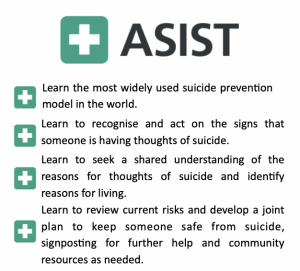
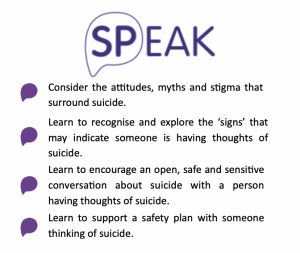
This report will consider the successes and challenges of the project, aiding our understanding of its overall impact and informing the future direction of suicide prevention initiatives to achieve the greatest reach and influence.
ASIST Training
Evaluation
Over the course of the year, one ASIST was delivered every quarter and these sessions were popular and well-attended. As can be seen in the Quantitative Data Overview table (see Appendix 1); none of the courses dropped below a 69% attendance rate, which is a strong feat for funded training where there is no financial loss for the participant if they do not attend. Participants were engaged from 28 of the 33 boroughs across London and represented a large variety of job roles, ranging from student advisors to administrators, to learning support and mentors. This demonstrates that the ASISTs had a wide reach and attracted staff in roles where contact with vulnerable students would be likely. Notably, those in more forward-facing roles, such as Safeguarding Officers and Counsellors, made up a large cohort of those who signed up but did not attend. This could be due to safeguarding incidents which arose that they needed to respond to or the inability to commit to two days of training outside of work.
Attendees of ASIST were asked to complete anonymous feedback forms at the end of each course to receive their certification. This is a standard process as defined by LivingWorks for all ASIST courses so they can be continuously updated and respond to suggested adjustments and keep delivery relevant. These forms do not collect any identity or background data for the purpose of maintaining anonymity, and so demographic data is not presented for those who attended ASIST. Nonetheless, the feedback has been useful to analyse, to support understanding of the overall impact of this project and how the ASIST training has influenced participants’ abilities and skills in suicide prevention (see Appendix 3 and 4).
The evaluation from these sessions demonstrates they were successful in achieving the project aim to upskill staff with the knowledge and skills to better understand suicide and suicide prevention. Participants’ general satisfaction with the course and agreement to its impact on their confidence, willingness, and ability to carry out an intervention is evident. 91% of attendees strongly agreed that they would recommend the course to others while 100% agreed or strongly agreed that they would ask a direct question if signs indicated someone is thinking about suicide. Given the fear people can have about asking this question, perhaps leading to more indirect ways of asking, it is promising to see that the training has helped to demystify this issue and given participants more confidence to speak plainly about suicide.
Participants’ written feedback reflects that they found the content of the training helpful, the facilitators to be skilful and the Pathway for Assisting Life (PAL) model, which is presented in the training, to be applicable in real-life situations. PAL provides a conversational structure to follow for suicide interventions with the aim of achieving ‘safety for now’ for the person experiencing thoughts of suicide. As one participant mentioned: “The model is very practical and such a useful framework”. This is also highlighted in the percentage increase, from pre- to post-training, of agreement or strong agreement regarding preparedness and confidence to undergo a suicide intervention (see Appendix 3, Q9 – Q12). Whilst we cannot know the number of students’ lives that will be saved as a result of this; it is evident that staff feel more confident to respond to these situations and to keep students safe.
One of the key benefits of the project is that staff could access the training at no cost and be in an environment amongst those working in the HE/FE fields. This ensured inclusivity for those with lesser financial support available and allowed those working in similar areas to share knowledge with each other. These opportunities may not have been available had they undergone other suicide prevention training outside of this project.
There were responses in the written feedback indicating some areas where participants would like to see changes or things they were dissatisfied with. This includes: the desire for training to be shorter and more condensed, its lesser relevancy for those who already have knowledge in suicide prevention, the use of gender pronouns on feedback forms, and the execution of exercises, such as the suicide simulations.
Constructive feedback can enable PAPYRUS and THRIVE LDN to reflect on how they target future training and streamline their application to specific roles. For example, more forward-facing staff such as therapists and student support should be encouraged to undertake ASIST, whereas administrative staff should be encouraged to undertake SP-EAK. This would enable those with less background knowledge in suicide prevention to gain a foundational understanding through SP-EAK, whereas those who are likely to regularly encounter people with thoughts of suicide can gain more in-depth knowledge and skills through ASIST. During this project, some of this targeting may have become secondary to prioritising getting as many staff as possible from HE/FE settings to attend either training.
Other feedback of this nature is directly related to the structure and content of the training and is therefore useful for LivingWorks to consider how they construct training material and course schedules. It also exemplifies how the use of gender pronouns can be made more inclusive in ASIST training content and its application by the trainers. This is an area PAPYRUS and THRIVE LDN can reflect on, to ensure ASISTs they deliver can be made more accessible to the LGBTQIA+ community, by applying gender pronouns in the most sensitive manner possible.
Overwhelmingly, attendees from ASIST courses felt that the training should be mandatory in their workplaces, which signifies that it has helped pave the way to meet the need for mental health- related training for staff in HE/FE and support them in preventing student suicides. This highlights the need to continue efforts, discussions and training relating to the prevention of student suicides across the city.
ASIST Attendance – Distribution By Borough
SP-EAK Training
Evaluation
Each participant was asked to complete a survey via an online SurveyMonkey web link before attending training and then directly after. The surveys were kept anonymous unless a participant gave their permission to be contacted at a later stage for a case study. The overall data provides helpful insight into where the PAPYRUS and THRIVE LDN project has made a difference in participants’ confidence in approaching the subject of suicide, as well as other areas where it impacted their skills and abilities relating to suicide prevention.
There were some recurrent themes mentioned in the qualitative feedback, including the training content being a good starting place for those who had not yet received any prior suicide prevention training, particularly in learning how to begin conversations around suicide. However, in terms of furthering the expertise of those who already work in mental health-related roles (e.g. counselling or therapeutic services), some participants found that the training content was not necessarily new or as impactful. Nonetheless, 93% of participants felt that the skills they learned in the training were applicable to their professional and/or personal life. Even where the data shows that 84% of participants already had prior beliefs that suicide is preventable, the post-session feedback demonstrates a 14%-point increase in those holding that belief following the training (see Appendix 7).
In addition, participants felt that the more practical activities in the training were most valuable and applicable to their job roles. For example, one attendee expressed that “I learnt to look for certain signs someone might be suicidal and how to ask the ‘direct question’ about it, and then to sign-post them”. Therefore, this encourages the idea that even for those who may have felt the content was not necessarily new learning for them, there were still valuable points in the training which were supportive of the work they are undertaking. One participant even highlighted that: “As a student Wellbeing Officer, there is ALWAYS an opportunity to develop and enhance my confidence and skills around suicide”.
Moreover, there was consistently high praise for trainers, with participants often mentioning them by name, suggesting that they had a memorable training experience. The mention of their delivery style being ‘sensitive’ is also apparent, with participants noting that the potentially difficult subject of suicide was made to feel more manageable by the trainers’ abilities to help them to feel at ease. Qualitative feedback also evidenced a realisation among participants that suicide can be spoken about safely and sensitively, as demonstrated by the way the trainers enabled this in their respective trainings (see Appendix 9). This is corroborated in the quantitative feedback of the sessions, with 98% of attendees stating that they felt the training was delivered safely and sensitively (see Appendix 7). In addition, attendees commented on trainers’ non-judgemental approach, meaning they felt more able to share their own experiences, concerns, and questions. Overall, most participants expressed that they felt the trainings were well worth their time, and a very useful space to have discussions around suicide which they may not have had elsewhere.
In terms of how the trainings could be improved; some common feedback which was received related to challenges with its length. Participants mentioned that they struggled with a 3.5-hour long training, especially without regular breaks between each section. It was also noted that the format could be improved for autistic people and those with ADHD. This is something for PAPYRUS to assess and consider how to ensure trainings are as inclusive and accessible as possible.
The data affirms the need for suicide prevention training to continue to be a prevalent and available tool for professionals in different capacities working in the HE/FE sector. Through delivery of the SP-EAK training, it is highly evident that there was a positive increase in knowledge relating to suicide prevention, confidence to recognise the signs someone may be thinking of suicide and supporting with safety planning.
SP-EAK Attendance – Distribution by Borough
Participant Demographic Data
The demographic data below is based on those who completed a pre-session survey (265 participants) before attending a SP-EAK training. As described above, demographic data is not presented for ASIST participants as the forms used in this training do not collect any identity or background data for the purpose of maintaining anonymity.
Ethnicity
The data shows that several groups were well-represented in the training, namely those who identified as ‘Mixed’, ‘Black/Black British – Caribbean’, ‘White British’ and ‘White Irish’ ethnic backgrounds. However, it should be noted that most ethnic groups were under-represented in relation to the overall ethnic diversity of London (see Appendix 8). This is a concern to address, with a need to look at how future projects can fully engage with a broader spectrum of ethnicities or focus on ethnic groups that have been under-represented in this project.
Gender
Whilst the project engaged those who identify as female, male and non-binary, there is a stark imbalance. Just under one in five participants were male, yet males account for approximately 75% of suicides. We must also take stock that only 2 people identified with a gender other than male and female – this is important as we know, for example, that “11 per cent of non-binary people … made an attempt to take their own life” in the previous year (Stonewall, 2018).
Other: Q1: 'Jed', 'Indian/Russian/Kazakh', '-', 'n/a', 'Prefer not to say', 'Assyrian' Q4: 'Latina', 'Prefer not to say. Age did not provide this option', 'n/a', 'White, Jewish', 'Turkish/Kurdish'
Other: Q1: ‘-‘, ‘n/a’, ‘prefer not to say’, Q4: ‘curious what the relevance of this question is?’
Age
There was representation from all age groups in the trainings across both Quarter 1 and Quarter 4, with a particular concentration within the 25-59 age groups.
Whilst this demographic data is for those who are being trained to support others, not explicitly those who are themselves experiencing thoughts of suicide, it is important to look at representation. With a greater representation of those trained, the logic follows that there will be a greater representation of those supported.
Conclusion
In total, 351 people from 84 institutions (31 HE and 53 FE) engaged with the training from all but one of the boroughs in London. There is tremendous value in many HE/FE staff now having new skills in suicide prevention that they did not have previously. The geographical breadth of engagement is a testament to the tenacity of staff to connect with many institutions, and the delivery of this project means nearly every borough in London has taken steps to become suicide safer.
Overall, of the HE and FE institutions which were engaged, many reported that they were invested in the training, felt they had developed substantial knowledge, and had multiple members of staff participate. The sessions were well received by participants, some even expressing it was the best training they had ever attended. The feedback from both the ASIST and SP-EAK training demonstrates that HE/FE staff feel more equipped to support students who may present with thoughts of suicide. Therefore, the project has achieved a key outcome as outlined in the initial contract – to upskill staff and institutions with the knowledge and skills to better understand suicide and suicide prevention.
Some organisations who took part had not previously engaged with THRIVE LDN or PAPYRUS, nor with suicide prevention training. Therefore, another success of this project is that they could access the training at no cost and build connections with two organisations that hold a suite of services and tools to build suicide-safer communities. Even the fact that participants now have HOPELINE UK (PAPYRUS’ suicide crisis line) to signpost to is a positive step towards giving suicidal students the right support to keep them safe.
Whilst, for now, the exact influence the training has had on another key outcome – the development of appropriate safeguarding procedures for vulnerable students – is not known, it can be acknowledged from the feedback that participants have gained new understandings around suicide which will support this endeavour. PAPYRUS and THRIVE LDN will be holding an in-person evaluation and review session for the project in Autumn 2023, where some more definitive answers around the development of safeguarding measures can be gathered.
The project has achieved very positive results, but there is also important insight and learning to consider:
- There was representation of participants from a variety of demographic groups, however, this representation was clearly imbalanced, with a lack of attendees from particular minority ethnic groups and those identifying with a gender other than female.
- The target to reach 300 institutions across all boroughs in London was ambitious. In and of itself, this number was a positive attempt to achieve a breadth of cover in training delivery. However, with finite time and staffing resources to drive promotion and outreach, this target may have been overly aspirational as an indicator of success.
- A change in project leads halfway through delivery meant time was needed for staff to become familiar with the project and build new relationships with stakeholders. Whilst this posed challenges to the momentum of the work, there was also much to be gained from having fresh perspectives and new people with fruitful contacts in the HE/FE fields. For example, connections were built with boroughs where there had been little to no engagement previously, including: Bexley, Bromley, Enfield, Hammersmith and Fulham, Harrow, Havering, Newham and Redbridge.
- Some of the difficulties in encouraging HE/FE staff to engage included:
- Establishing a strong rapport with institutions that had never been engaged with before
- Organisations not feeling they had the time to attend training
- A reluctance to engage with the sensitive subject matter
- In addition to the above, another reason targets may not have been met is due to there being quite a high number of dropouts across training courses (with a higher drop-out rate in SP-EAKs than ASISTs – see Appendix 1 and 5). This is not a new issue with funded projects; when training is made free for attendees, there is no financial loss for them due to non-attendance and thus there is less accountability.
- Some participant feedback demonstrates that they felt the information provided was more general knowledge which they already had about suicide prevention. They recommended that it could be more targeted towards people who would be less likely to have this foundation of understanding; suggesting that this training should be reserved for people in roles such as administrators or student advisors. Those in these positions would presumably not have as much background awareness on the subject, yet, could still be likely to be first responders to a student experiencing thoughts of suicide. This can help Papyrus and THRIVE LDN to reflect on how best to target, and manage expectations around, future trainings to ensure attendees gain the right level of skill and competence for their roles.
Recommendations
- With clear positive outcomes arising from this project, momentum must not be halted in the support offered to HE/FE Institutions. Much of the feedback suggests that this training was useful for HE/FE staff to gain more confidence and preparedness to undergo suicide interventions with students. Further engagement and review with HE/FE staff could be implemented to understand the most effective next steps to prevent student suicides.
- Demographic data gathered in this project points to the need to engage further and deeper with our local communities in London. Future work could make concerted efforts to liaise with groups under-represented in this project, to understand local need and how best to meet it.
- Future project proposals could use this project as a learning opportunity to look at the staffing resource and time required to reach targets. Further to this, consideration could be given to how we engage key contacts in local areas to support the outreach and promotion of future offers, for example, by including other bodies such as local councils.
- Consideration should be taken regarding how to maximise attendance at trainings by reducing the drop-out rate. For example, this may be achieved through sending more reminders to those who have signed up or perhaps offering further incentives to attend.
- Future projects could further define the level of training suggested for particular roles, to help ensure attendees get the appropriate input to support them in their particular contexts.
The project has been a significant step on the journey to creating suicide-safer communities for students, by equipping more staff in colleges and universities across London with the knowledge and confidence to undergo suicide interventions. This momentum must be sustained as no young person should have to struggle alone with thoughts of suicide.
Appendices
Appendix 1: ASIST Quantitative Data Overview
|
ASIST Dates |
HE Attendees |
FE Attendees |
Total / Sign-Ups |
Attendance Rate |
|
ASIST 1 (Q1) 13.06.22-14.06.22 |
17 |
9 |
26 / 26 |
100% |
|
ASIST 2 (Q2) 21.07.22-22.07.22 |
15 |
5 |
20 / 29 |
69% |
|
ASIST 3 (Q3) 24.11.22-25.11.22 |
9 |
7 |
16 / 23 |
69.6% |
|
ASIST 4 (Q4) 23.02.23-24.02.22 |
9 |
16 |
25 / 30 |
83.3% |
|
All ASISTs |
50 |
37 |
87 / 108 |
90.6% |
Appendix 2: ASIST Training by Borough
|
Distribution by Borough – ASIST |
HE Attendees |
FE Attendees |
Borough Total |
Region Total |
||
|
NW London |
Brent |
0 |
1 |
1 |
21 |
|
| Ealing |
7 |
0 |
7 |
|||
| Hammersmith & Fulham |
0 |
1 |
1 |
|||
| Harrow |
0 |
1 |
1 |
|||
| Hillingdon |
0 |
2 |
2 |
|||
| Hounslow |
0 |
0 |
0 |
|||
| Kensington & Chelsea |
1 |
1 |
2 |
|||
| Westminster |
5 |
2 |
7 |
|||
|
NE London |
Barking & Dagenham |
2 |
0 |
2 |
10 |
|
| Hackney |
1 |
1 |
2 |
|||
| Havering |
0 |
1 |
1 |
|||
| Newham |
2 |
0 |
2 |
|||
| Redbridge |
0 |
0 |
0 |
|||
| Tower Hamlets |
1 |
0 |
1 |
|||
| Waltham Forest |
0 |
2 |
2 |
|||
|
NC London |
Barnet |
2 |
0 |
2 |
24 |
|
| Camden |
10 |
5 |
15 |
|||
| City of London |
3 |
0 |
3 |
|||
| Enfield |
0 |
2 |
2 |
|||
| Haringey |
0 |
0 |
0 |
|||
| Islington |
2 |
0 |
2 |
|||
|
SW London |
Croydon |
0 |
3 |
3 |
19 |
|
| Kingston |
3 |
4 |
7 |
|||
| Merton |
1 |
2 |
3 |
|||
| Richmond |
1 |
0 |
1 |
|||
| Sutton |
0 |
0 |
0 |
|||
| Wandsworth |
3 |
2 |
5 |
|||
|
SE London |
Bexley |
0 |
1 |
1 |
13 |
|
| Bromley |
0 |
3 |
3 |
|||
| Greenwich |
5 |
0 |
5 |
|||
| Lambeth |
0 |
3 |
3 |
|||
| Lewisham |
0 |
0 |
0 |
|||
| Southwark |
1 |
0 |
1 |
|||
|
Pan London |
0 |
0 |
0 |
0 |
||
Appendix 3: Post-ASIST Feedback
R = Rating
n = Number of participants
% = Percentage of participantsQ5 – Q12 = Likert Scale
Strongly Agree (SA), Agree (A), Neutral (N), Disagree (D), Strongly Disagree (SD)
|
Quarter 1 (27 participants) |
Quarter 2 (19 participants) |
Quarter 3 (16 participants) |
Quarter 4 (25 participants) |
Total (87 participants) |
|||||||||||
|
R |
n |
% |
R |
n |
% |
R |
n |
% |
R |
n |
% |
R |
n |
% |
|
|
Q1 How would you rate ASIST? (1 = did not like at all; 10 = liked a lot) |
10 |
17 |
63% |
10 |
14 |
74% |
10 |
13 |
81% |
10 |
20 |
80% |
10 |
64 |
74% |
|
9 |
6 |
22% |
9 |
2 |
11% |
9 |
1 |
6% |
9 |
1 |
4% |
9 |
10 |
12% |
|
|
8 |
3 |
11% |
8 |
1 |
5% |
8 |
2 |
13% |
8 |
3 |
12% |
8 |
9 |
10% |
|
|
7 |
1 |
4% |
7 |
2 |
11% |
7 |
– |
– |
7 |
– |
– |
7 |
3 |
3% |
|
|
6 |
– |
– |
6 |
– |
– |
6 |
– |
– |
6 |
1 |
4% |
6 |
1 |
1% |
|
|
Q2 Would you recommend ASIST to others? (1 = definitely no; 10 = definitely yes) |
10 |
25 |
92% |
10 |
16 |
84% |
10 |
14 |
88% |
10 |
24 |
96% |
10 |
79 |
91% |
|
9 |
1 |
4% |
9 |
– |
– |
9 |
2 |
13% |
9 |
– |
– |
9 |
3 |
3% |
|
|
8 |
1 |
4% |
8 |
2 |
11% |
8 |
– |
– |
8 |
1 |
4% |
8 |
4 |
5% |
|
|
7 |
– |
– |
7 |
1 |
5% |
7 |
– |
– |
7 |
– |
– |
7 |
1 |
1% |
|
|
Q3 This workshop has practical use in my personal life. (1 = definitely no; 10 = definitely yes) |
10 |
18 |
67% |
10 |
13 |
68% |
10 |
12 |
75% |
10 |
21 |
84% |
10 |
64 |
74% |
|
9 |
– |
– |
9 |
– |
– |
9 |
1 |
6% |
9 |
1 |
4% |
9 |
2 |
2% |
|
|
8 |
3 |
11% |
8 |
1 |
5% |
8 |
1 |
6% |
8 |
1 |
4% |
8 |
6 |
7% |
|
|
7 |
4 |
15% |
7 |
1 |
5% |
7 |
– |
– |
7 |
– |
– |
7 |
5 |
6% |
|
|
6 |
2 |
7% |
6 |
2 |
11% |
6 |
– |
– |
6 |
– |
– |
6 |
4 |
5% |
|
|
5 |
– |
– |
5 |
1 |
5% |
5 |
2 |
13% |
5 |
2 |
8% |
5 |
5 |
6% |
|
|
1 |
– |
– |
1 |
1 |
5% |
1 |
– |
– |
1 |
– |
– |
1 |
1 |
1% |
|
|
Q4 This workshop has practical use in my work life. (1 = definitely no; 10 = definitely yes) |
10 |
24 |
89% |
10 |
16 |
84% |
10 |
14 |
88% |
10 |
21 |
84% |
10 |
75 |
86% |
|
9 |
1 |
4% |
9 |
– |
– |
9 |
1 |
6% |
9 |
1 |
4% |
9 |
3 |
3% |
|
|
8 |
– |
– |
8 |
1 |
5% |
8 |
1 |
6% |
8 |
2 |
8% |
8 |
4 |
5% |
|
|
7 |
1 |
4% |
7 |
1 |
5% |
7 |
– |
– |
7 |
1 |
4% |
7 |
3 |
3% |
|
|
5 |
– |
– |
5 |
1 |
5% |
5 |
– |
– |
5 |
– |
– |
5 |
1 |
1% |
|
|
2 |
1 |
4% |
2 |
– |
– |
2 |
– |
– |
2 |
– |
– |
2 |
1 |
1% |
|
|
Q5 If a person’s words and/or behaviours suggest the possibility of suicide, I would ask directly if he/she is thinking about suicide |
SA |
22 |
82% |
SA |
16 |
84% |
SA |
16 |
100% |
SA |
24 |
96% |
SA |
78 |
90% |
|
A |
5 |
19% |
A |
3 |
16% |
A |
– |
– |
A |
1 |
4% |
A |
9 |
10% |
|
|
Q6 Before taking the ASIST training, my answer to Q5 would have been: |
SA |
7 |
26% |
SA |
6 |
32% |
SA |
5 |
31% |
SA |
5 |
20% |
SA |
23 |
26% |
|
A |
11 |
41% |
A |
6 |
32% |
A |
6 |
38% |
A |
9 |
36% |
A |
32 |
37% |
|
|
N |
7 |
26% |
N |
3 |
16% |
N |
2 |
13% |
N |
9 |
36% |
N |
21 |
24% |
|
|
D |
2 |
8% |
D |
3 |
16% |
D |
2 |
13% |
D |
1 |
4% |
D |
8 |
9% |
|
|
SD |
– |
– |
SD |
1 |
5% |
SD |
1 |
6% |
SD |
1 |
4% |
SD |
3 |
3% |
|
|
Q7 If someone told me he or she was thinking of suicide, I would do a suicide intervention. |
SA |
22 |
82% |
SA |
14 |
74% |
SA |
13 |
81% |
SA |
21 |
84% |
SA |
70 |
80% |
|
A |
5 |
19% |
A |
4 |
21% |
A |
2 |
13% |
A |
4 |
16% |
A |
15 |
17% |
|
|
N |
– |
– |
N |
1 |
5% |
N |
1 |
6% |
N |
– |
– |
N |
2 |
2% |
|
|
Q8 Before taking the ASIST training, my answer to Q7 would have been: |
SA |
7 |
26% |
SA |
4 |
21% |
SA |
4 |
25% |
SA |
1 |
4% |
SA |
16 |
18% |
|
A |
10 |
37% |
A |
5 |
26% |
A |
6 |
38% |
A |
11 |
44% |
A |
32 |
37% |
|
|
N |
7 |
26% |
N |
6 |
32% |
N |
2 |
13% |
N |
7 |
28% |
N |
22 |
25% |
|
|
D |
3 |
11% |
D |
3 |
16% |
D |
3 |
19% |
D |
4 |
16% |
D |
13 |
15% |
|
|
SD |
– |
– |
SD |
1 |
5% |
SD |
1 |
6% |
SD |
2 |
8% |
SD |
4 |
5% |
|
|
Q9 I feel prepared to help a person at risk of suicide |
SA |
20 |
74% |
SA |
10 |
53% |
SA |
11 |
69% |
SA |
18 |
72% |
SA |
59 |
68% |
|
A |
6 |
22% |
A |
9 |
47% |
A |
2 |
13% |
A |
7 |
28% |
A |
24 |
28% |
|
|
N |
1 |
4% |
N |
– |
– |
N |
3 |
19% |
N |
– |
– |
N |
4 |
5% |
|
|
Q10 Before taking the ASIST training, my answer to Q9 would have been: |
SA |
5 |
19% |
SA |
2 |
11% |
SA |
3 |
19% |
SA |
3 |
12% |
SA |
13 |
15% |
|
A |
10 |
37% |
A |
6 |
32% |
A |
5 |
31% |
A |
5 |
20% |
A |
24 |
28% |
|
|
N |
8 |
30% |
N |
7 |
37% |
N |
2 |
13% |
N |
12 |
48% |
N |
29 |
33% |
|
|
D |
3 |
11% |
D |
3 |
16% |
D |
4 |
25% |
D |
2 |
8% |
D |
13 |
15% |
|
|
SD |
1 |
4% |
SD |
1 |
5% |
SD |
2 |
13% |
SD |
3 |
12% |
SD |
8 |
9% |
|
|
Q11 I feel confident I could help a person at risk of suicide |
SA |
18 |
67% |
SA |
12 |
63% |
SA |
11 |
69% |
SA |
17 |
68% |
SA |
58 |
67% |
|
A |
8 |
30% |
A |
7 |
37% |
A |
3 |
31% |
A |
7 |
28% |
A |
25 |
29% |
|
|
N |
1 |
4% |
N |
– |
– |
N |
2 |
13% |
N |
1 |
4% |
N |
4 |
5% |
|
|
Q12 Before taking the ASIST training, my answer to Q11 would have been: |
SA |
5 |
19% |
SA |
4 |
21% |
SA |
1 |
6% |
SA |
2 |
8% |
SA |
12 |
14% |
|
A |
9 |
33% |
A |
6 |
32% |
A |
5 |
31% |
A |
6 |
28% |
A |
26 |
30% |
|
|
N |
6 |
22% |
N |
6 |
32% |
N |
2 |
13% |
N |
10 |
4% |
N |
24 |
28% |
|
|
D |
7 |
26% |
D |
2 |
11% |
D |
4 |
25% |
D |
2 |
8% |
D |
15 |
17% |
|
|
SD |
– |
– |
SD |
1 |
5% |
SD |
4 |
25% |
SD |
4 |
16% |
SD |
10 |
12% |
|
Q13-15 of the ASIST feedback form have been omitted, as they are not relevant in evaluating the impact of the training. In any case, all participants marked 100% yes to these questions.
Appendix 4: ASIST Quantitative and Qualitative Data Analysis by Quarter

Quarter 1: April-June 2022
In this quarter, question 2 depicts the greatest satisfaction with the course, where 92% of participants rated 10 (definitely yes) and no one rated below an 8. This demonstrates that the group saw enough value in the training to encourage others to participate, which is also reflected in the written feedback. Five people stated that they would be recommending the course to others. However, in comparison to the other courses which took place, this one had the lowest number of people who rated 10 for question 1. Nonetheless, no one rated below a 7 for this question, demonstrating that there was still a general feeling that ASIST was a good training course to participate in.
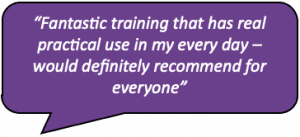
This course also had a lower percentage of those who felt that the training would be useful in their personal lives, with 67% of people rating 10 (definitely yes) on question 3. This may be because they were attending as part of their roles working in a HE/FE environment, and so their focus would have likely been more towards supporting students. This can be highlighted by the fact that this course had the highest percentage of those who strongly agreed that the workshop had a practical use in their work life, with 88.6% rating 10 (definitely yes) to question 4.

The most demonstratable impact on this group was in their increased preparedness and confidence to help a person at risk of suicide; reflected in their responses to questions 9-12. There was a 56%-point increase in a rating of strongly agreed preparedness to help a person at risk of suicide and a 48%-point increase in strongly agreed confidence to do so, after the training. This is also reflected in the written feedback where participants have reflected on their confidence and increased knowledge of suicide prevention.
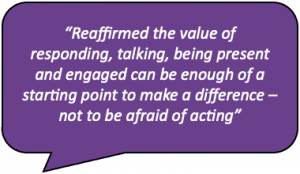
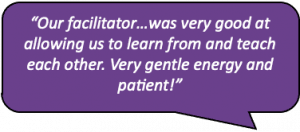
The general sentiment of the written feedback from this session was that the course content was well received, the trainers were engaging, and participants would recommend it to their colleagues and networks. Most participants commented on how much the training built their confidence in supporting students with thoughts of suicide and that they felt the skills they learned would be applicable to their roles. Any constructive criticism that was received from this ASIST was in response to the evaluation form itself.

Quarter 2: July – September 2022

The most identifiable influence on the participants of this ASIST was their agreement to initiate a suicide intervention with someone, with there being a 53%-point increase in strong agreement to do so following the training. This is highlighted in their responses to questions 7 and 8, which demonstrates that this group felt an increased willingness to undertake an intervention with someone. Once again, in this course, one of the highlights often cited was the skills of the trainers and their ability to create a comfortable and safe environment. A few people even said that they felt the training should be made mandatory.

In comparison to the other quarters, this one had the lowest rate of recommendation of the course to others, with 84% rating 10 (definitely yes) to question 2. This is also reflected in the written feedback, with this course receiving the most constructive comments, including the use of gender pronouns, the temperature of the room, the length of the training and the desire for more practical exercises. Nonetheless, this is still a high percentage of people who would highly recommend ASIST and none of the participants rated lower than a 7 for this question.
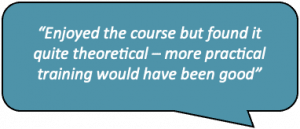
Quarter 3: October-December 2022

In this quarter, there was a noticeably high strong agreement to ask a person if they are thinking about suicide if their behaviour indicates this possibility, with 100% rating strongly agree to question 5. Their increase in likelihood to do so after the training is also depicted in their responses to question 6, where there is a 69%-point difference in strong agreement. This course also reflected the highest rating of ASIST, with 81% of people rating 10 to question 1. This is highlighted in the written feedback provided and the fact that no constructive comments were given, which accentuates that the group found the training to be a positive experience.

The themes of the written feedback were that the participants really valued the course content, and found that the suicide intervention model, the Pathway for Assisting Life (PAL), was easy to follow. They also tended to find that putting what they learnt into practice through role-play was a useful tool.
As this was the smallest group who participated, this means that they perhaps would have had more of the trainers’ individual attention, as well as earlier finishing times in comparison to the other groups, potentially adding to their positive perception of the training.
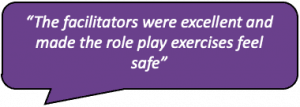
Quarter 4: January-March 2023

Interestingly, the participants on this course rated it more highly in comparison to others in having practicality in their personal lives, with 84% strongly agreeing to question 3, a 9% margin higher than the quarter 3 training, which had the second highest rate of strong agreement to this statement. It would be difficult to clarify why this may be the case; perhaps more people who attended the training already had personal experiences with suicide, however, this is an estimation and there is no way of knowing this.
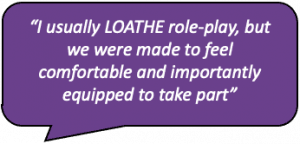
This course also had the highest rate of strong agreement with question 7, with 84% strongly agreeing they would undergo an intervention. In comparison to those who would have done so before the training, this shows an 80%-point increase. This highlights that the course had a profound effect on participants’ willingness to undergo an intervention and whilst we cannot definitively know how many lives this will save, it does indicate that a large cohort of participants will be more prepared in preventing suicide if an incident arises.

Similarly, to the other ASIST courses, the written feedback received from this one conveys that the participants felt they gained a lot from the content and that the trainers created a safe place where they felt they could step outside of their comfort zone. A couple of participants even commented that they felt the ASIST was the best training course they have ever taken part in. Some constructive feedback which was received involved the potentially triggering nature of one of the exercises in the training.

Appendix 5: SP-EAK Quantitative Data Overview
|
SP-EAK Dates |
HE Attendees |
FE Attendees |
Other Attendees* |
Total / Sign Ups |
Attendance Rate |
|
SP-EAK 1 (Q1) 04.05.22 |
5 |
7 |
1 |
13 / 22 |
59.1% |
|
SP-EAK 2 (Q1) 12.05.22 |
11 |
11 |
1 |
23 / 27 |
85.2% |
|
SP-EAK 3 (Q1) 18.05.22 |
16 |
7 |
1 |
24 / 29 |
82.8% |
|
SP-EAK 4 (Q1) 23.05.22 |
12 |
8 |
1 |
21 / 26 |
80.8% |
|
SP-EAK 5 (Q1) 31.05.22 |
14 |
4 |
0 |
18 / 30 |
60% |
|
SP-EAK 6 (Q1) 08.06.22 |
7 |
11 |
0 |
18 / 19 |
94.7% |
|
SP-EAK 7 (Q1) 14.06.22 |
6 |
6 |
1 |
13 / 19 |
68.4% |
|
SP-EAK 8 (Q1) 23.06.22 |
7 |
5 |
1 |
9 / 18 |
50% |
|
SP-EAK 9 (Q4) 10.01.23 |
9 |
9 |
0 |
18 / 29 |
62.1% |
|
SP-EAK 10 (Q4) 16.01.23 |
7 |
8 |
1 |
16 / 25 |
64% |
|
SP-EAK 11 (Q4) 25.01.23 |
6 |
11 |
2 |
19 / 30 |
63.3% |
|
SP-EAK 12 (Q4) 06.02.23 |
14 |
5 |
0 |
19 / 29 |
65.5% |
|
SP-EAK 13 (Q4) 15.02.23 |
7 |
9 |
0 |
16 / 22 |
72.7% |
|
SP-EAK 14 (Q4) 21.02.23 |
10 |
5 |
0 |
15 / 22 |
68.2% |
|
SP-EAK 15 (Q4) 06.03.23 |
13 |
6 |
0 |
19 / 26 |
73.1% |
|
SP-EAK 16 (Q4) 14.03.23 |
8 |
12 |
0 |
20 / 23 |
87% |
|
ALL SP-EAKs |
152 |
124 |
9 |
285 / 396 |
72% |
*’Other Attendees’ includes people who were not strictly working in Higher or Further Education settings, for example, THRIVE LDN Project Officers or Metropolitan Police Officers.
Appendix 6: SP-EAK Distribution Across London Boroughs
|
Distribution by Borough – SP-EAK |
HE Attendees |
FE Attendees |
Borough Total |
Region Total |
|
|
NW London |
Brent |
0 |
3 |
3 |
28 |
| Ealing |
5 |
3 |
8 |
||
| Hammersmith & Fulham |
3 |
2 |
5 |
||
| Harrow |
0 |
2 |
2 |
||
| Hillingdon |
1 |
0 |
1 |
||
| Hounslow |
0 |
0 |
0 |
||
| Kensington & Chelsea |
2 |
0 |
2 |
||
| Westminster |
5 |
2 |
7 |
||
|
NE London |
Barking & Dagenham |
3 |
7 |
10 |
43 |
| Hackney |
3 |
7 |
10 |
||
| Havering |
0 |
6 |
6 |
||
| Newham |
7 |
2 |
9 |
||
| Redbridge |
0 |
1 |
1 |
||
| Tower Hamlets |
3 |
2 |
5 |
||
| Waltham Forest |
0 |
2 |
2 |
||
|
NC London |
Barnet |
6 |
12 |
18 |
109 |
| Camden |
41 |
11 |
52 |
||
| City of London |
7 |
8 |
15 |
||
| Enfield |
0 |
7 |
7 |
||
| Haringey |
0 |
4 |
4 |
||
| Islington |
11 |
2 |
13 |
||
|
SW London |
Croydon |
0 |
7 |
7 |
64 |
| Kingston |
6 |
4 |
10 |
||
| Merton |
0 |
1 |
1 |
||
| Richmond |
19 |
0 |
19 |
||
| Sutton |
0 |
7 |
7 |
||
| Wandsworth |
17 |
3 |
20 |
||
|
SE London |
Bexley |
0 |
9 |
9 |
29 |
| Bromley |
0 |
3 |
3 |
||
| Greenwich |
6 |
1 |
7 |
||
| Lambeth |
2 |
1 |
3 |
||
| Lewisham |
3 |
1 |
4 |
||
| Southwark |
1 |
2 |
3 |
||
| Pan-London |
1 |
2 |
3 |
3 |
|
Appendix 7: SP-EAK – Comparison of Pre and Post-session Survey Data
| Comparing Pre-session and Post-session Survey Data |
Q1 |
Q4 |
TOTAL |
| Pre: I feel knowledgeable about the subject of suicide |
77 (56.2%*) |
58 (45.3%) |
135 (50.9%) |
| Post: I am better informed about suicide prevention |
71 (85.5%) |
105 (92.9%) |
176 (89.8%) |
| Change in percentage points: |
29.3 |
47.6 |
38.9 |
| Pre: Many young suicides can be prevented |
119 (86.9%) |
103 (80.5%) |
222 (83.8%) |
| Post: Many young suicides can be prevented |
80 (96.4%) |
111 (98.2%) |
191 (97.4%) |
| Change in percentage points: |
9.5 |
17.7 |
13.6 |
| Pre: I feel confident recognising someone at risk of suicide |
70 (51.1%) |
43 (33.6%) |
113 (42.6%) |
| Post: There are often signs that a young person might be thinking about suicide |
79 (95.2%) |
109 (96.5%) |
188 (95.9%) |
| Change in percentage points: |
44.1 |
62.9 |
53.3 |
| Pre: I feel confident asking a young person if they are having thoughts of suicide |
100 (73%) |
81 (63.3%) |
181 (68.3%) |
| Post: I feel confident asking a young person if they are having thoughts of suicide |
79 (95.2%) |
108 (95.6%) |
187 (95.4%) |
| Change in percentage points: |
22.2 |
32.3 |
27.1 |
| Pre: I am confident in using safety plans (removing ‘N/A’ – therefore based on 86 answers for Q1 and 78 answers for Q2; therefore 164 for TOTAL) |
43 (50%) |
34 (43.6%) |
77 (47%) |
| Post: I feel confident to support a young person in completing a suicide safety plan |
74 (89.2%) |
104 (92%) |
178 (90.8%) |
| Change in percentage points: |
39.2 |
48.8 |
43.8 |
| Other Post-session Data | Q1 (83) | Q4 (113) | TOTAL (196) |
| The training met my expectations |
89.2% |
89.4% |
89.3% |
| I would recommend the training to others |
90.4% |
91.2% |
90.8% |
| The content was delivered sensitively and safely |
96.4% |
99.1% |
98.0% |
| The trainer was knowledgeable and encouraged participation |
95.2% |
98.2% |
96.9% |
| The skills learnt are applicable to my personal and professional life |
91.6% |
94.7% |
93.4% |
*Percentage who answered Strongly Agree or Agree - applies throughout the two tables
Appendix 8: Demographic Data Analysis
Key: ![]()
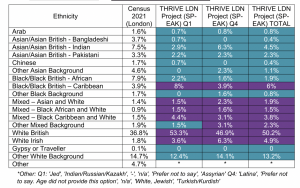
Appendix 9: SP-EAK Quantitative and Qualitative Data Analysis

Quarter 1: April-June 2022
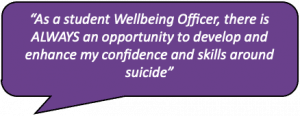
The most significant impact of the training on participants in this quarter is in their confidence to recognise that someone may be experiencing thoughts of suicide. There is a 44.1%-point increase in agreeing and strongly agreeing with the related question from pre to post-training. As there is a whole section in SP-EAK which is dedicated to understanding the signs and knowing what they could be, this reflects that this was an important and influential part of the training. This is also echoed in the written feedback, wherein the pre-session survey, participants commented that they were hoping to gain an understanding of the signs that someone might be having thoughts of suicide. They also mentioned that they would like to further their skills and refresh their knowledge, as they recognised that there is always room for more learning around suicide awareness.
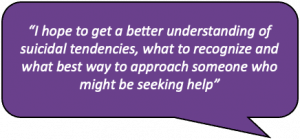
There is also a noticeable percentage difference in participants’ general knowledge of the subject of suicide; with a 29.3%-point increase in agreement or strong agreement in feeling better informed about suicide prevention in the post-session feedback, as opposed to the pre-session feedback. What may have aided the participants learning, similarly to what was also well received in ASIST, was the skills and abilities of the trainers. In the post-session survey, participants frequently commented that the trainers were sensitive, non-judgemental, and very knowledgeable about suicide. Interestingly, what was unique to one of the training sessions was that a Papyrus HOPELINEUK Advisor (working on Papyrus’ support service for young people thinking about suicide and those concerned about a young person who might be) was present. Attendees of this session mentioned that having someone there who was able to share stories and real-life examples of conversations they had with vulnerable young people was invaluable.
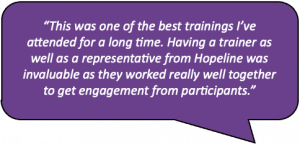
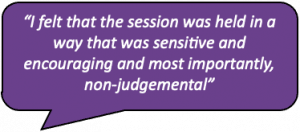
In this quarter, there is only a marginal difference in agreement or strong agreement pre and post-training to the statement “many young suicides can be prevented”, with only a 9.5%-point difference in the post-session feedback. This demonstrates that many participants already held this belief. While lots of them did learn new knowledge from the trainings, others with prior history of working with people with thoughts of suicide commented on the familiarity of the content. Akin to the ASIST training, this can help PAPYRUS and THRIVE LDN consider how they target appropriate attendees for either training and match their skill set to the correct level.
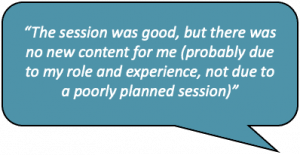
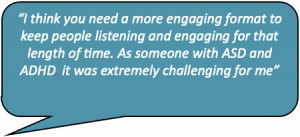
Some other constructive feedback received was that participants struggled without breaks for the longer segments of the training. This is something PAPYRUS can reflect on in incorporating more intervals to aid learning and make courses more inclusive.
PAPYRUS also delivered a ‘SP-EAK +’ session in quarter 1 on 22 June 2022. This was to help solidify the participants’ learning from their SP-EAK training. Only four people attended this session and three of them provided feedback. All participants ‘agreed’ that the session met their expectations and that they would recommend the session to others. Participants differed in their perspective with regards to the training solidifying their learning, with ‘strongly agree’, ‘agree’ and ‘neither agree nor disagree’ being selected by the three participants. All participants ‘agreed’ or ‘strongly agreed’ that the session gave them a good opportunity to share learning and network with colleagues working across London. However, whilst this session seemed to be of some benefit, PAPYRUS made a wider decision to remove the SP-EAK + training offer from across all its platforms, as it was concluded that they were not proving to be successful. This is why no other SP-EAK + sessions were completed as part of this project.

Quarter 2 and 3: July-December 2022
Midway through the project, in August 2022, there was a change in leads at both Papyrus and THRIVE LDN due to staff leaving and priorities changing. This meant that there was also a change in when and where training would take place. It had already been decided that any SP-EAK training due to happen over the summer (July – September) would be postponed, as this was the period in which HE/FE would be on their summer break. Thereafter, when the new leads came on board, they needed time to reach out and promote the trainings to raise awareness and encourage sign ups. This is why the SP-EAK trainings which were due to happen in autumn and winter (September – December) were also postponed. There was one ASIST which still took place during each of these periods, as they already had a large cohort assigned to them and so their cancellation was unnecessary. The postponed SP-EAK training took place in quarter 4, with some of the funding decidedly re-purposed from what was originally supposed to be SP-EAK+ sessions into some more SP-EAKs and one extra ASIST.
Quarter 4: January-March 2023
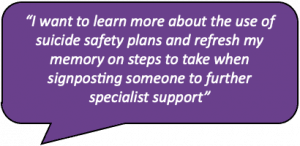
In this quarter, there is a noticeable impact on the upskilling of knowledge through participants’ confidence in using a safety plan, with there being a 48.8%-point increase in the agreement or strong agreement to the related question. This was further highlighted in the pre-session survey, where participants commonly mentioned that they were keen to learn more about Papyrus’ suicide safety plan (a plan to keep someone safe from suicide which is looked at during the training) and feel more equipped in using it, as well as wanting to hone their skills to best support young people. Papyrus’ safety plan encourages a holistic, rather than clinical, approach in undergoing a conversation about suicide safety, and it’s encouraging to see participants’ comfort with, and understanding of, this approach.
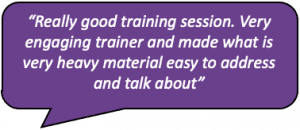
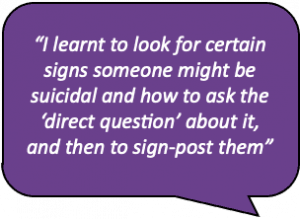
In comparison to the first quarter, this quarter had a larger difference between pre- and post-training in confidence to ask a young person if they are having thoughts of suicide. There is a 32.3%-point increase in agreement or strong agreement to this, which is 10.1%-points higher than the first quarter. This again could be due to the abilities of the trainers to create safe spaces where the activity of asking about suicide, which can be one of the most difficult parts of a suicide intervention, was made to feel comfortable. This was also demonstrated in participants’ feedback, where they commented that they felt more confident leaving the training and found that the safe spaces which were created by activities were useful.
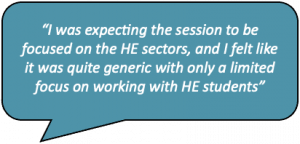
Similarly, to the first quarter, the lowest difference in the agreement or strong agreement between pre and post-training was in relation to the statement “many young suicides can be prevented” with there being a 17.7%-point increase post-training. This could also be because those attending worked in the HE/FE sector and so having a sense of care towards students and preventing suicide may have already been a given for many of them. Participants did express a desire for more content and examples specific to the fields they worked in. Considering the project was aimed specifically towards people in the HE/FE sector, Papyrus and THRIVE LDN can reflect on how to make future training offers more tailored to the audiences they are targeting and include information which is relevant for them.
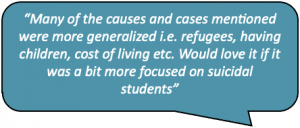
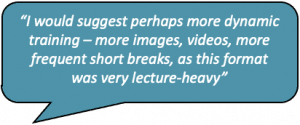
Where there was other constructive feedback was in the style of the training and the amount of theoretical versus practical content. As could be seen in response to ASIST; some participants attending SP-EAK in this quarter would have liked for there to be more time dedicated to the practical exercises. As everyone has a different learning style, considerations can be made in how to make future training more inclusive, for example incorporating more visual and active learning.